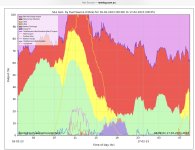Hillhater
100 TW
The Australian situation is complicated buy the way the grid deals with its independent generator power supply contractors.australia here, some observations:
rooftop solar has been massive in australia, 1 in 4 homes recorded as having them in 2020 ( csiro data), we are having closures of coal powered generation plants.
Now the really odd thing about all this is: those still paying for grid electricity are paying more than ever, the prices just keep going up and up.
Go figure?
In simple terms, The “Wholesale Market” ( buying power from independent generators) is a rolling auction system with generators “bidding” a supply price (per MWh) for each 5 minute sector of demand.
the lowest bid set the price paid to all suppliers for that period.
Unfortunately, this system is open to abuse ( market “gaming”) , especially where some generators operate both fossil generators as well as Wind and Solar generators, and when there are shortages of supply due to the unreliability of RE systems and the premiture closure of Coal geneerators.
This results in the reliance on expensive Gas “peaker” generators to fill the gaps.
Ultimately this leads to massive fluctuations ($30 - $14,000/MWh) in the wholesale price throughout the day..depending on the weather and spot demand.
Those cost fluctuations are adsorbed by the Retail suppliers who spread them out over a long period , (12 months ?) and add on the various overheads and margins to arrive at a set consumer cost
this log of power supply mix in SA ( a state with more % RE than others) gives an indication og the wild fluctuations in supply mix throughout the day..
Attachments
Last edited:


